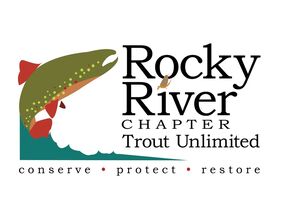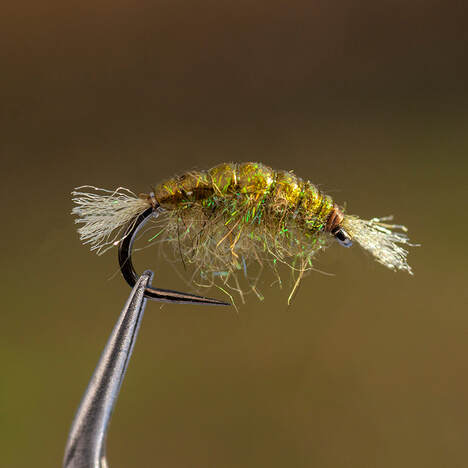Fly of the Month 12.22
There is a creature that trout love to eat that lives in and around aquatic grass in shallow waters mostly only hip deep where there is thick aquatic vegetation. They are 100% aquatic, totally underwater always. It is a Crustacean and close relative of the crayfish and shrimp. They are active all year long, all seasons. However, with many other choices to imitate during the spring, summer and fall, these creatures become most important to the angler during the winter months. Their presence in the right habitat can produce at least twenty percent of a trout’s diet. So, it’s presence often leads to larger trout. The creature is a scud! However, we are presenting a special version, the Ultraviolet Scud (tied with materials that reflect a special wavelength of light believed to be more visible to trout).
UV Scud
Many fly fishers refer to scuds as freshwater shrimp. The difference between them is in their legs. Shrimp have three distinct sections with their legs all near their head section. Scud have fourteen sets of legs spread along the entire lower body. An easy way to know the difference is when you pick one up, a scud will curl into a curve shape and a shrimp will try to spring away from you. Thus, the reason most scud fly patterns are tied on a curved hook. The curved shape may well represent a scud out of water or spent and drifting in a current, but while in the water swimming or climbing on vegetation, a scud is not so curved. Tying scud fly patterns on a straight shanked hook can be just as appropriate as an imitation. A challenging and unusual scud fly pattern to consider is a “double scud” or “mating scud” as scud piggy back each other to mate. (from FOTM 02.17 Scud)
There are ninety species of scud found in North America. The species of importance to we anglers and the trout is the Gammaridae family. The most obvious habitats for scud are spring creeks and tailraces with a high pH that produce an abundance of aquatic vegetation. However, some streams that are influenced by nutrient flows from hatcheries upstream or managed farming run-off also grow shore line grasses with root systems and stems underwater. If you fish the South Holston River tailrace in East Tennessee, the Scud or UV Scud is a must have fly pattern to carry. (from FOTM 02.17 Scud)
Young scud molt about a dozen times before they become adults. Thus, to imitate a scud, tie same fly pattern in different sizes from size 12 to size 22 and in the colors of gray, tan, green, yellow, cream and orange. Smaller size 22 or size 20 should only be gray, tan or green and larger size 12 or size 14 should only be yellow or cream. UV material may be used for any of these colors but the actual effectiveness is suspect.
Orange scud, a scud with and orange spot or scud with a band of orange are more precise imitations and can be very important to pay attention to. UV material for the orange is ideal. These color variations are important due a parasite Pomphorhynchus laevis that lives in the intestinal tract of a scud and turns part of the scud orange thus forming an orange band. The parasite uses the scud as a carrier to ultimately get into the intestinal tract of a fish where it completes its life-cycle, while all along feeding off both carriers. If a scud dies with the parasite, the entire scud turns orange in color. Scud that die without the parasite turn cream in color.
Another color variation is a scud fly pattern with a distinct orange spot or “hot spot” which imitates an egg bearing scud. Scud mate from late spring, when the water warms up, through to the late summer or early fall, when the water cools. The fall is the ideal time to fish the egg bearing scud as the vegetation dies down and the “hot spot” is very visible. In general, scud are active year-round. However, with more choices to imitate in the warmer months, scud fly patterns are a good choice during winter fly fishing.
Scud do not like bright lights, thus in general, a scud fly pattern is more effective during times of low light around dawn and dusk and during overcast days. Otherwise, scud fly patterns must be heavy enough to get down near bottom where scud hide away from any intense daylight. To get the scud fly pattern down on vegetation, either a heavy hook, added lead (or lead substitute) wire as an underbody, or a bead is typically used. Some scud fly patterns place the bead in the center of the body, hidden away under the legs of picked out dubbing. Since the bead typically imitates an air bubble and this is not a characteristic of a scud, a bead either should not be used or should be well hidden.
Scud are good swimmers, but they swim in short bursts of speed and in an erratic almost sideways manner. Your retrieve should be somewhat jerky and ready for a soft take.
UV Scud
Fly of the Month 12.22
Tom Adams and Alen Baker
There is a creature that trout love to eat that lives in and around aquatic grass in shallow waters mostly only hip deep where there is thick aquatic vegetation. They are 100% aquatic, totally underwater always. It is a Crustacean and close relative of the crayfish and shrimp. They are active all year long, all seasons. However, with many other choices to imitate during the spring, summer and fall, these creatures become most important to the angler during the winter months. Their presence in the right habitat can produce at least twenty percent of a trout’s diet. So, it’s presence often leads to larger trout. The creature is a scud! However, we are presenting a special version, the Ultraviolet Scud (tied with materials that reflect a special wavelength of light believed to be more visible to trout).
UV Scud
Many fly fishers refer to scuds as freshwater shrimp. The difference between them is in their legs. Shrimp have three distinct sections with their legs all near their head section. Scud have fourteen sets of legs spread along the entire lower body. An easy way to know the difference is when you pick one up, a scud will curl into a curve shape and a shrimp will try to spring away from you. Thus, the reason most scud fly patterns are tied on a curved hook. The curved shape may well represent a scud out of water or spent and drifting in a current, but while in the water swimming or climbing on vegetation, a scud is not so curved. Tying scud fly patterns on a straight shanked hook can be just as appropriate as an imitation. A challenging and unusual scud fly pattern to consider is a “double scud” or “mating scud” as scud piggy back each other to mate. (from FOTM 02.17 Scud)
There are ninety species of scud found in North America. The species of importance to we anglers and the trout is the Gammaridae family. The most obvious habitats for scud are spring creeks and tailraces with a high pH that produce an abundance of aquatic vegetation. However, some streams that are influenced by nutrient flows from hatcheries upstream or managed farming run-off also grow shore line grasses with root systems and stems underwater. If you fish the South Holston River tailrace in East Tennessee, the Scud or UV Scud is a must have fly pattern to carry. (from FOTM 02.17 Scud)
Young scud molt about a dozen times before they become adults. Thus, to imitate a scud, tie same fly pattern in different sizes from size 12 to size 22 and in the colors of gray, tan, green, yellow, cream and orange. Smaller size 22 or size 20 should only be gray, tan or green and larger size 12 or size 14 should only be yellow or cream. UV material may be used for any of these colors but the actual effectiveness is suspect.
Orange scud, a scud with and orange spot or scud with a band of orange are more precise imitations and can be very important to pay attention to. UV material for the orange is ideal. These color variations are important due a parasite Pomphorhynchus laevis that lives in the intestinal tract of a scud and turns part of the scud orange thus forming an orange band. The parasite uses the scud as a carrier to ultimately get into the intestinal tract of a fish where it completes its life-cycle, while all along feeding off both carriers. If a scud dies with the parasite, the entire scud turns orange in color. Scud that die without the parasite turn cream in color.
Another color variation is a scud fly pattern with a distinct orange spot or “hot spot” which imitates an egg bearing scud. Scud mate from late spring, when the water warms up, through to the late summer or early fall, when the water cools. The fall is the ideal time to fish the egg bearing scud as the vegetation dies down and the “hot spot” is very visible. In general, scud are active year-round. However, with more choices to imitate in the warmer months, scud fly patterns are a good choice during winter fly fishing.
Scud do not like bright lights, thus in general, a scud fly pattern is more effective during times of low light around dawn and dusk and during overcast days. Otherwise, scud fly patterns must be heavy enough to get down near bottom where scud hide away from any intense daylight. To get the scud fly pattern down on vegetation, either a heavy hook, added lead (or lead substitute) wire as an underbody, or a bead is typically used. Some scud fly patterns place the bead in the center of the body, hidden away under the legs of picked out dubbing. Since the bead typically imitates an air bubble and this is not a characteristic of a scud, a bead either should not be used or should be well hidden.
Scud are good swimmers, but they swim in short bursts of speed and in an erratic almost sideways manner. Your retrieve should be somewhat jerky and ready for a soft take.
UV Scud
Fly of the Month 12.22
Tom Adams and Alen Baker

